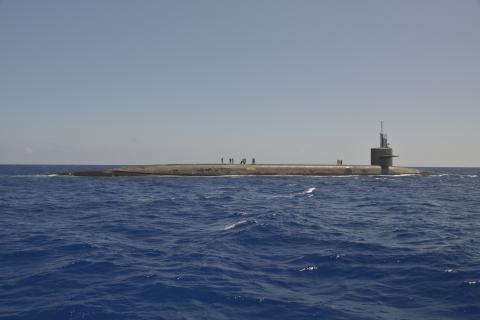
During the 1980s and '90s, the U.S. Navy built a fleet of nuclear-armed submarines. Their mission? Deter an attack against the United States, and, if that failed, fight a nuclear war.
Those submarines are now approaching the end of their life spans. The Navy plans to build replacements, but there's growing debate over how many are needed and how to pay for them.
Veteran Pentagon reporter Jamie McIntyre, who is now national security correspondent for Al-Jazeera America, has been on special assignment for the "NewsHour." A transcript of his latest interview for the project can be found below.
***
JUDY WOODRUFF: During the 1980s and '90s, the U.S. Navy built a fleet of nuclear-armed submarines. Their mission? Deter an attack against the United States, and, if that failed, fight a nuclear war.
Those submarines are now approaching the end of their life spans. The Navy plans to build replacements, but there's growing debate over how many are needed and how to pay for them.
Veteran Pentagon reporter Jamie McIntyre, who is now national security correspondent for Al-Jazeera America, has been on special assignment for the NewsHour. His report was produced in partnership with the Pulitzer Center on Crisis Reporting.
MAN: Man battle stations, missile. Spin up all missiles.
MAN: Sound the general alarm.
JAMIE MCINTYRE: If America's strategy of nuclear deterrence ever fails, the beginning of the end might look something like this.
The U.S. Navy's ballistic missile submarines are all part of the Ohio class, named for the first submarine of the design, the USS Ohio. They have only one mission: to lurk silently, deep beneath the ocean, ready to rain nuclear devastation on virtually any target anywhere any time on orders of the president.
Submerged just off the coast of Hawaii, the 180-man crew of the USS Pennsylvania demonstrated for the PBS NewsHour an abridged version of what it practices every week the sub is at sea. The submarine's video screens display only unclassified data.
MAN: We have a verified and correct launch order directing the launch of missiles 7, 3, and 5.
JAMIE MCINTYRE: And the Navy reviewed our footage to ensure nothing was compromised. What we saw was a mock doomsday scenario.
MAN: This is the captain. This is an exercise.
JAMIE MCINTYRE: The launching of three nuclear-tipped missiles, enough to destroy several major cities and kill millions of people.
It's a drill where there can be no questioning of orders, no consideration of consequences, no second thoughts. Lieutenant A.J. Walker is the triggerman, whose job is to what's euphemistically termed close the circuit.
This is the missile compartment. It what makes this submarine such a fearsome weapon, 24 missile tubes, each one capable of holding a Trident missile with multiple independently targeted warheads. That means this single ship could deliver massive destructive power to multiple targets around the globe.
To critics back in Washington, that raises an obvious question: If one submarine can bring on Armageddon, how many does the U.S. really need?
Joseph Cirincione is president of the Ploughshares Fund, a foundation that supports eliminating nuclear weapons.
JOSEPH CIRINCIONE, President, Ploughshares Fund: One sub carries at its minimum the equivalent of 600 Hiroshimas. If they launched those missiles, if they launch those warheads, it would be a destructive event beyond history.
JAMIE MCINTYRE: It's not just an academic argument. The military commander of America's nuclear arsenal, Admiral Cecil Haney, wants to upgrade the aging fleet of 14 Ohio class ballistic missile subs in the coming decades by building 12 new next-generation subs.
ADM. CECIL HANEY, U.S. Strategic Commander: Replacing the Ohio class submarine is one of my top priorities.
JAMIE MCINTYRE: Each submarine has a price tag of upwards of $5 billion, although, when you count research and development, the total price climbs to over $100 billion, according to the Congressional Budget Office.
VICE ADM. MIKE CONNOR, Commander, U.S. Submarine Forces: However you want to calculate it, this fleet is a bargain.
JAMIE MCINTYRE: Vice Admiral Mike Connor commands the Navy submarine forces. At his headquarters in Norfolk, Virginia, he makes the case for an almost one-for-one replacement of the current fleet, arguing the cost is just 1 percent of the overall defense budget, while the benefit is incalculable, measured, he says, in wars that never start.
VICE ADM. MIKE CONNOR: The truth is that we use them every day to deter a major power war.
JAMIE MCINTYRE: The ballistic missile submarine is an awesome war machine. At 560 feet, it is as long as the Washington Monument is high, yet nearly invisible to enemy eyes when slinking silently deep beneath the waves, which makes it the most survivable leg of America's nuclear triad of subs, bombers, and land-based missiles.
VICE ADM. MIKE CONNOR: And what would happen if they did attempt a massive strike, no matter how massive that strike was, the submarine force that is at sea would survive and be in a position to retaliate.
JAMIE MCINTYRE: As the U.S. cuts the number of nuclear weapons in the latest round of reductions negotiated with the Russians, submarines will play an outsized role in the deterrence mission, carrying 70 percent of America's active nuclear arsenal.
Still, critics like Ploughshares' Joe Cirincione argue building enough new subs to destroy the world a dozen times over is expensive overkill.
JOSEPH CIRINCIONE: If you just need this to be a deterrent force, to respond in case someone is crazy enough to actually attack the United States and thereby deter them from ever doing that, well, you really could be talking about four, five, six nuclear submarines, each of which would have 16 missile tubes, each of which would carry five or six warheads. That's a lot of nuclear weapons.
JAMIE MCINTYRE: But, as Admiral Connor war-games various worst-case scenarios, involving Russia, China, and North Korea, he insists the psychological calculus of deterrence can't be reduced to a simple math problem.
VICE ADM. MIKE CONNOR: So you think about an intelligent adversary, and our adversaries, in a peer competitor situation, they are intelligent, they are thinking adversaries, you wouldn't want to have a situation where there is an incentive where they say, you know, if we strike on this day or when this ship is being repaired or when they're just leaving port and the other one is just coming in, that maybe the balance of force would change in our favor.
JAMIE MCINTYRE: But, ultimately, it could be money, not strategy, that torpedoes the Navy's pricey plan to design and build a state-of-the-art sub to replace the current 14.
SEN. RICHARD BLUMENTHAL (D), Connecticut: The cost of that program has been estimated in the range of $100 billion. The Navy has said that it cannot pay for it out of its Navy budget.
JAMIE MCINTYRE: At his Senate hearing to be confirmed as Joint Chiefs chairman, General Joseph Dunford agreed paying for a whole new fleet of subs out of the regular ship building account would bust the Navy's budget.
GEN. JOSEPH DUNFORD, Commandant, U.S. Marine Corps: And what I can tell you with a degree of surety is that, were we to fund the Ohio class replacement out of the Department of the Navy, it would have a pretty adverse effect on the rest of the ship building plan, and the estimates are between two-and-a-half and three ships a year.
NORMAN POLMAR, Naval Historian: The cost is — some people would say outrageous. I just say it's tremendous.
JAMIE MCINTYRE: Naval historian and consultant Norman Polmar says, either way you fund the plan, through the normal budget or a special account, it's unaffordable, and unworkable.
NORMAN POLMAR: If Congress were to fund the Navy strategic submarines out of a separate fund, tomorrow afternoon, the Air Force would come in and say, hey, Congress has approved a new bomber; we want that funded out of a separate strategic fund.
JAMIE MCINTYRE: Polmar says there are smarter, cheaper ways to buy the same level of nuclear deterrence. Modifying smaller attack submarines already in service, he argues, would allow the Navy to buy fewer of the bigger ballistic missile subs.
NORMAN POLMAR: Today, every attack submarine can carry Tomahawk land attack conventional missiles. Most of our submarines have vertical launch tubes for 12 of these Tomahawk missiles. Those missiles tomorrow or, say, a couple of years could have nuclear warheads.
JAMIE MCINTYRE: But the Navy counters, the smaller attack subs don't have the endurance of the bigger boomers, and that their cruise missiles don't have the intercontinental range, nor carry multiple warheads that can destroy different targets.
And advocates for far deeper weapons cuts say the whole debate underscores the folly of expensive new nuclear weapons that would only be used if a war were essentially already lost.
This plaque shows the USS Pennsylvania was launched in April of 1988. That makes it over a quarter-century old. It, like other submarines of its class, was designed for 30 years of service, which means it would have been decommissioned in the next couple of years. But now the Navy says it's figured out how to keep those submarines running for an extra 12 years.
Commander John Cage is captain of the USS Pennsylvania.
So, you have showed us around your boat. It looks great. Everything looks like it's spit-polished and shiny. It looks like this boat could go on forever.
CMDR. JOHN CAGE, USS Pennsylvania: She still has a lot of life left in her. But it's definitely getting on in the years. There's things that — we have a lot of redundant systems, that I find myself using those redundant systems a little bit more. Certain components will fail. Certain things are just starting to run past their lifetime.
MAN: Dive. Dive.
MAN: All vents open.
JAMIE MCINTYRE: But the sub's crew is still prepared to make the unthinkable reality.
CMDR. JOHN CAGE: We do think about it. I mean, it's definitely not something we want to happen. Nobody in the boat wants it to happen.
JAMIE MCINTYRE: How would you handle the crew on the boat after a launch like that, when no one would sort of know what — the fate of the world be hanging in the balance. How do you keep a crew together after…
CMDR. JOHN CAGE: I will tell you, that would be difficult. One of the reasons why we train so frequently, the evolution you saw, we do time and time again, so it becomes something that we can execute immediately and quickly. But after that would be a very difficult time.
JAMIE MCINTYRE: For this submarine, a successful deployment is one where the only projectiles from the sea are the bottlenose dolphins who playfully surf the sub's bow as it prepares to dive.
Jamie McIntyre for the PBS NewsHour, aboard the USS Pennsylvania, off the coast of Hawaii.
JUDY WOODRUFF: Online, we have a lot more about nuclear-armed submarines. You can watch extended excerpts of the interviews we featured, and see how submarines get resupplied at sea. All that is on our Web site, PBS.org/NewsHour.





